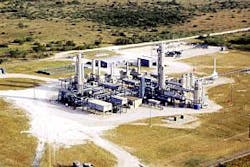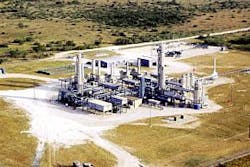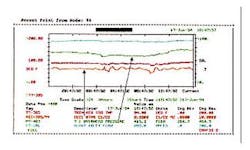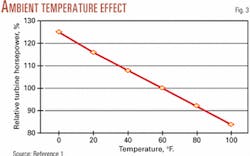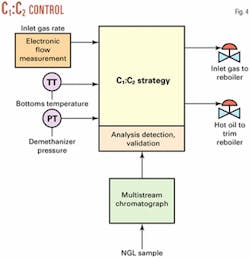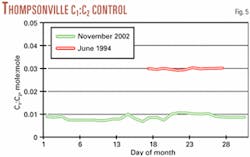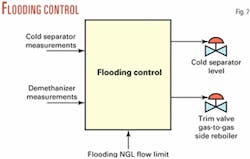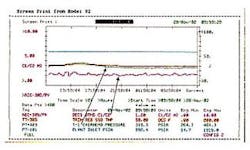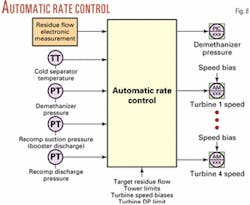Advanced regulatory control strategies at El Paso Field Services Co.'s Thompsonville, Tex., gas plant have optimized plant performance for the past 9 years with little or no required maintenance, according to John R. Phillips of El Paso Field Services Co., San Antonio, and Barry D. Payne of Barry D. Payne & Associates Inc., Stafford, Tex.
In a presentation to the Gas Processors Association 82nd Annual Convention, Mar. 9-12, 2003, San Antonio, Payne and Phillips outlined the implemented strategies that reduced operator intervention and improved control and process economics.
They said that the strategies were implemented in the plant's distributed control system (DCS) and required no additional computers. Engineering costs were the only system installation outlays required.
null
Automatic multivariable C1:C2 ratio control helps maintain high C2+ recoveries, reduces "methane giveaway," and eliminates the need for operators periodically to compensate for tower pressure, inlet rate, inlet composition, and ambient temperature effects, according to the authors.
The plant operator was able to reduce unexpected upsets caused by tower flooding using a flooding prevention strategy, which provided several years of protection until process design changes rendered it unnecessary.
The authors said that the strategy required little engineering labor to design and commission and no additional instrumentation. The system, therefore, was inexpensive and required little or no maintenance during its term of service.
Tower flooding protection included online estimation of liquid rates and automatic exchanger balancing to limit liquid production and feed rates. Rapid-response logic for expander and compressor trips reduced operator intervention and minimized the impact of equipment trips; this prevented tower overpressure or recompressor shutdowns due to low suction, they said.
Automatic rate control coordinates tower pressure and recompressor speeds, which gives tighter control of volumes delivered to residue markets. Automatic rate adjustment on a full-time basis reduces operator intervention, according to the authors.
They said that this strategy also controls plant inlet pressure to improve recovery and stabilize production pressures. It includes additional constraints that reduce the likelihood of upsets and increase plant reliability and operator confidence.
Plant history
El Paso Field Services Co. currently operates the 300-MMcfd turboexpander gas plant near Thompsonville, Tex., originally built by Valero Hydrocarbons Co. in 1992. The plant originally processed 250 MMcfd; gas was supplied from Valero's intrastate pipeline network with residue delivery to off-system markets.
The initial design was a single-expander, basic cryogenic process with four Solar Centaur turbine recompressors, two of which had waste-heat recovery (Fig. 1a).
The plant's control system included a DCS for process control, a programmable logic controller (PLC) for shutdowns and mole-sieve-dehydration sequence control, and individual PLCs for equipment control and protection of the expander and four turbines.
The different advanced control strategies have been in service 6-9 years and have performed reliably with minimal maintenance.
Control systems
When the plant first started up in 1992, the operator successfully commissioned automatic C1:C2 control to maintain high recoveries, prevent methane giveaway, and reduce the need for operator intervention, according to Phillips and Payne.
Simple chromatograph-based control in gas processing plants presents two problems: Multistream chromatographs result in long delays in sample-to-control action, and chromatograph sample systems can be somewhat unreliable.
The solution was a strategy that uses the analyzer in combination with tower pressure and inlet rate dynamically to compensate for disturbances even when the analyzer is between updates. The strategy includes an error checking logic that reduces the impact of analysis failures, according to the authors.
Fig. 2 shows a screen print trend from 1994.
They said that, after commissioning, the plant experienced periodic upsets from tower flooding known as "cold spin;" this compelled the operator to design and install a "cold spin" controller in 1993.
Tower flooding reduces yield and can lead to off-spec product and unplanned shutdowns. Small changes in inlet-gas temperature and composition, such as those caused by ambient temperature variations, can lead to large changes in the amount of NGL fed to the demethanizer. Some facilities have experienced variations of 10-100% of normal flow, according to the authors.
Liquid carryover is one result of tower flooding. Liquid flashes in the exchanger train, which provides excessive refrigeration. This increases the tower feed or carries overhead liquid from the separator into the expander if the level valve is at full capacity.
This phenomenon often occurs late at night, and the operator may not notice it until the plant is severely upset. A tower flooding controller prevented this situation. After successful testing, it was in service for several years.
Phillips and Payne said that, in 1996, the plant owner wanted to increase the control of daily flow variations due to gas control requirements. Because the plant operates as a base-loaded facility, the ability to maintain consistent flow control is important.
Turboexpander plants normally operate in one of two modes: automatic rate control based on a simple inlet-pressure controller connected to the expander or recompressor controls, or as a manual flow control system with operator-adjusted tower pressure or recompressor speeds, they said.
The Thompsonville plant was using manual flow control in 1996. The operator adjusted recompressor speeds or the tower pressure set point to maintain flow rates. Variations in ambient temperature and humidity, inlet pressure, or residue pressure cause the rate to drift slightly. Operating in this mode leads to infrequent changes, according to the authors.
In South Texas, summer temperatures cause the turbine horsepower to decline during the day and rise in the evening (Fig. 3). This results in smaller, more frequent operator adjustments or larger, occasional steps as the flow or inlet pressure deviates from the target.
They said that this affects residue delivery rates and also causes the operator to make frequent adjustments to improve recovery when the ambient temperature drops and extra horsepower becomes available. The operator commissioned a plant flow strategy with constraints for inlet, residue, and processing conditions to optimize the flow rate.
In 1997, the plant owner added an Ortloff gas subcooled process (OGJ, Dec. 13, 1999, p. 93), which included an absorption tower and demethanizer reflux, and another Centaur for higher recovery and capacity (Fig. 1b).
This eliminated the potential for tower flooding, so that the operator could remove the cold spin controls. As of 2002, the C1:C2 ratio and gas processing rate controls were still in service. Maintenance, other than that for field devices, has been limited to a small number of tuning visits since 1992, according to the authors.
Composition control strategy
The strategy automatically adjusts reboiler duty according to changes in tower operating pressure, bottoms temperature, and changes in the C1:C2 ratio detected by the bottoms product chromatograph analyzer, said Phillips and Payne.
The control strategy also automatically adjusts the reboiler duty according to changes in plant throughput because it controls the inlet gas reboiler and the heating medium trim reboiler (Fig. 4). The operator does not make manual adjustments unless C1:C2 specifications change.
Operation
A combination of analyzer feedback and predictive pressure compensation determines the target reboiler temperature. The system monitors the bottoms product: It checks any new analysis against limits and, if found valid, the analysis correction mode is entered, according to the authors.
The strategy goes online for a short interval during each analyzer cycle. It makes small adjustments in the demethanizer bottoms conditions if the C1:C2 ratio is not on target.
Analyzer feedback combines with pressure, inlet rate, and bottoms temperature data to determine reboiler duties for the inlet gas and hot-oil trim reboilers. The reboiler strategy controls gas to the inlet-gas bottom and side reboilers, and heat to the trim reboiler.
They said that a key element in the demethanizer bottoms composition strategy is the logic that determines when a new chromatograph analysis is available, and that verifies its validity.
The composition feedback leads to an adjustment in the C1:C2 ratio only when a valid new analysis is reported. Concurrently, the system uses tower pressure, bottoms temperature, and inlet rates to continuously adjust reboiler duties to maintain the composition at or near the "last known good" value, according to the authors.
The analyzer feedback logic allows the operator to bypass the analyzer for maintenance without losing other functions.
Results
The C1:C2 controller has operated since 1992 with only occasional offline periods for analyzer repair or ethane rejection, when the plant operates at maximum reboiler duty, the authors said.
In 1994, daily average C1:C2 samples (Fig. 5) produced standard deviations of 0.03 mole % at 3 mole % target. In November 2002, the daily averages for the month had a standard deviation of 0.11 mole % at a 1 mole % target.
Due to negligible ethane margins, limiting "methane giveaway" is an economic priority. Variation in composition is a bit larger and composition control is more nonlinear as a component's value decreases towards zero.
Phillips and Payne said that this controller has operated at one third of the original set point (Fig. 6) for 8 years with only a minor retuning a few years ago. Controller maintenance requires retuning less than once every year.
The last DCS software change was in 1996, when the operator added a minor logic revision to improve response speed, according to the authors.
Flooding control
In 1994, the demethanizer was experiencing flooding problems, they said. A review by operations and the engineering contractor revealed that the liquid feed from the cold separator exceeded feed-tray-liquid loading limits.
The operator installed a flooding limiter, which performed an inferential tower feed rate estimate that limited the cold separator level controller when tower feed exceeded its limit (Fig. 7).
These data show the Thompsonville C1:C2 control trend in 2002 (Fig. 6).
The strategy limited the tower feed production rate by continuously readjusting the balance between the upper side reboiler and gas-to-gas exchangers, according to Phillips and Payne.
Operation
A model estimated the cold separator tower feed liquid rates and limited them to an operator-set target.
Once the model limited the feed rate, it limited the feed production to maintain steady state by rebalancing the gas-to-gas exchanger and side-reboiler duties.
The authors said that this method permitted continuous flooding-free operation while avoiding unnecessary production losses.
Results
To test the system, the operator reduced the cold separator bottoms flow target to less than normal.
The strategy limited liquid production by overriding the differential temperature controller and changing the flow ratio between the upper side reboiler and the gas-to-gas exchanger, according to the authors.
They said that, after commissioning, flooding problems occurred because the flow limit was set 5-10% greater than the estimated flooding limit. Reducing the flow limit below the flooding limit corrected the problem. This indicated that the flooding flow estimate was fairly accurate.
The cold spin logic remained in service until 1997 when the plant owner installed an Ortloff process that eliminated the problem of cold separator feed tray flooding.
Rate control
The gas processing rate controller performs only residue flow control, although the design can also operate in inlet and residue control modes, according to the authors.
The strategy includes constraints for maximum and minimum demethanizer pressure, minimum cold separator temperature, and maximum differential pressure between the residue recompressors' discharge and suction.
Manipulated variables include the demethanizer pressure set point and the turbine recompressor speed set points (Fig. 8).
To maximize recoveries, the plant operator configured the strategy to adjust demethanizer pressure preferentially. This maximized turbine speed; the strategy can also selectively reduce turbine speed to conserve horsepower.
Phillips and Payne said that the strategy was designed to maintain a maximum turbine speed set point as long as the demethanizer pressure set point was above its lower limit and could be adjusted by the flow strategy.
One of three factors determines the demethanizer pressure lower limit set point: the cold separator temperature limit, the turbine differential pressure limit, or a manually set lower limit.
If residue flow is above its set point and the demethanizer pressure controller set point is at its low limit, the strategy will decrease the turbine speed set point. The amount of decrease is the difference between demethanizer target pressure and the set point, adjusted with a gain factor.
Turbine speed set points are scaled and limited to a range of 92-100%, according to the authors.
The strategy, therefore, will always lower the tower pressure to the proper value at maximum turbine speed or to whichever low limit is in effect.
This provides for near-optimum recovery performance with respect to tower pressure.
System logic places the flow strategy in manual mode if the expander shuts down; the controls track the tower pressure set point and turbine speeds to provide a "bumpless" switch to automatic after a restart.
'Bumpless' transfer logic
When the expander shuts down or when the operator puts the flow strategy in manual, the strategy must follow the demethanizer pressure controller set point.
When the plant flow control is put back in service, the demethanizer pressure set point will not upset, or "bump," the process, according to the authors.
To ensure that any turbine switched to local at the PLC panel will not get a "bump" in speed, biases in the turbine speed automatic-manual transfer stations are forced to track the difference in the plant flow strategy output signal and actual turbine speed signals.
They said that this tracking will stop when the operator remotely controls demethanizer pressure and enables the plant flow strategy.
Results
Automatic rate control was installed at Thompsonville in 1996 (Fig. 9). Automatic rate control resulted in this residue flow trend (Fig. 9).
The controls have reduced variations in target and nominated rates significantly, according to Phillips and Payne.
In 1996, the flow routinely deviated 3-5 MMcfd (1.0-1.7%). Monthly reports for daily flow averages in November 2002 showed a standard deviation of 1.7 MMcfd (0.6%) even though the strategy has not been retuned in several years.
They said that operations routinely engage and disengage the flow controls for maintenance.
Reference
1. GPSA Engineering Data Book, 11th edition, Gas Processors Suppliers Association, Tulsa, 1998.
